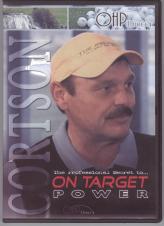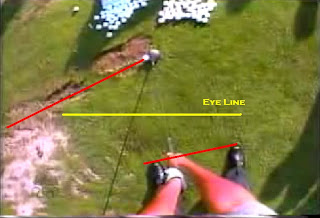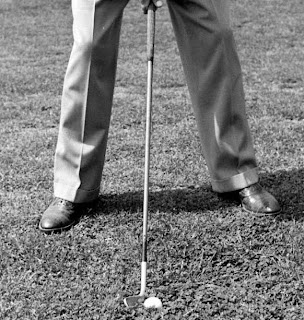Left Side Snap Golf Swing – by Michael Cortson © 2010
All golfers have one thing in common. They all want to hit the ball farther. The laws of motion govern how far the ball will go. I have studied the “golf swing”, if you will, for over 20 years. I have been fortunate enough to have been a PGA Tour Player Manager and had the opportunity to observe the world’s finest players up close. I also had the privilege of working with John Schlee who was Ben Hogan’s only pupil. John passed onto me what he specifically called “The Secret”. I have already published that information in my book “The Secret to a Great Golf Swing” and also demonstrated it in my DVD “On Target Power”. I didn’t stop there. I have continued to experiment and study. My understanding of the “swing” and how to create maximum club head speed have led to this paper.
With a swing we are trying to create force. The formula for force is mass times acceleration equals force, ma = f. Mass is the only constant in this formula; i.e. the club head. The only variable then is acceleration. So the issue is, how do we create more acceleration? More importantly, how do we create maximum acceleration with the club face square at impact?
John told me that in his first lesson the very first thing Hogan asked him; “John, show me your impact position.” John was perplexed at such a question but it was coming from the foremost authority so he tried to get into what he thought was his “impact position”. This makes total sense. We are trying to achieve square contact at maximum velocity. We need a full understanding of just how one creates this velocity.
There are two forces at work in a swing. 1) The linear motion of the club head and 2) The centripetal or pulling force exerted on that club head. That’s right, pulling force. A simple demonstration is the rock on a string example. You could use a yoyo. When you twirl the rock or yoyo on a string how do you increase the speed of the projectile? You pull harder on the string. The hard you pull the faster it goes. You have to maintain your balance for the projectile to keep moving smoothly. What happens if you let go of the string? The projectile flies straight away. That is the linear motion I mentioned above.
Can you twirl a projectile faster with a long string or a short string? You can twirl a short one faster, of course. So speed will actually increase with a shorter string or radius for this circular motion. This revelation dispels the widely touted “wider arc creates more speed”. A short string pulled hard creates speed. I am not going to chop my clubs down. I am going to use my clubs as designed while applying these principles I have outlined above.
At impact I want to have my body in a position where I can apply the most pull as possible to generate the most speed I can. This means pulling the string harder. So what position would I have to be in at impact? First I had to determine where was the center of the radius? I’d read over and over that the center of the swing was the spine and even more specifically, the 7th cervical vertebrae. Wrong! The center of this swing radius is the tip of the left shoulder (for right-handers). That is where the arm and club shaft rotate around. This revelation changed everything.
I realized that since the tip of the left shoulder is the center all of the pulling force had to be applied at that point to create maximum centripetal force. This force coupled with the linear force of the club head creates the fictional force we call centrifugal force which is not a force but a byproduct. This pulling force has to go up. That’s right up and away from the ball. To create that pulling force I focus on driving my left shoulder up. The faster I pull the shoulder upwards the fast the club head will swing.
I began my experiment by jerking my left shoulder up while holding a 5 iron comfortably at address. I had to use my entire body to get my shoulder to pull the club. What I immediately noticed was when I made this upward motion my hips turned to the left as my left arm fell against my stomach. I had my left side straightened and all of my weight over my left foot. I also noticed that my club face opened up with the heel of the club now leading dramatically. I thought to myself that I would have to somehow twist the club face shut in order to compensate for this. Then it occurred to me why not get into that impact position with my left arm fully extended, my hips turned with all of my weight over my left foot and simply adjusted the club face to be square to my target line and then taking my grip on the handle. I did that. Without changing my grip I relaxed back into my address position and noticed my club face closed. I figured that the club face would square itself up if I simply snapped myself back into the impact position. It did. I just stepped into the impact position and back to the address over and over without taking any back swing. I observed the club face squaring up without any manipulation of my hands or arms.
I began making short swings and to my amazement I generated a great amount of speed with this simple body motion. Note that I was not trying to hit the ball with my hands and arms. Quite the contrary, I was trying not to hit at all and simply rely on the physics I described above to create the power. It worked. The only time I faltered was when I tried to do something active with my hands and arms.
I started my swing from my new impact position and swung the club head back and then snapped back into the impact position which was indeed quite easy to do. Hogan called that muscle memory. Whatever you call it, it bloody works. The more comfortable I got with this new method the more I became aware of just how to apply this new force in the same manner I learn to twirl that rock on a string. If I deviated from the method the swing broke down. It took a little getting used to but the results are dead straight a long shots. Balanced force in motion using physics. There are no piano throwing muscles in the golf swing; that is for sure.
One thing I did realize was the left wrist position as shown to me by John Schlee happens automatically when I start from this new impact position. I don’t even have to think about it. You will find that you do not need a long back swing to achieve maximum force. You will realize that this left side snap as I call it is the power source. You will also find that your arms will stay close to your body making it easy for your core to turn more quickly. This is the application of conservation of angular momentum just as the ice skater used to spin faster. The turn toward the target using this method happens as a result of the left shoulder moving upward. The left shoulder goes up and the hips follow. The club head, like the rock, just whips through.
I intend to detail these findings in a video soon. If you have any questions feel free to email me at mike@mikecortson.com .
Hit ‘em straight!














